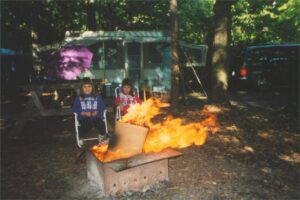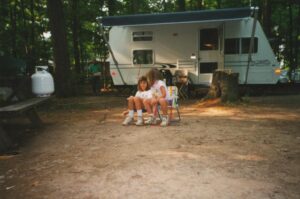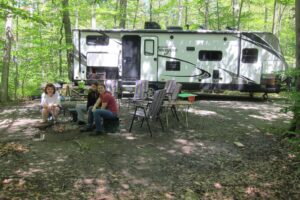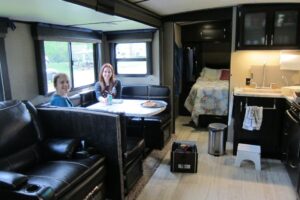Aside from our Disney vacations, camping is our “big thing”. With myself having two months off in the summer, I’m one of the few people who could make good usage of a trailer. There have been years where we were away camping on more days that we were actually home!
We do two types of camping: (1) Camping in ‘woodsy’ areas for quiet getaways and (2) Using the camper as a portable hotel room while touring. Pre-CoVid, we camped a lot in NY state in and around the finger lakes region. Since then, we’ve found a few nice conservation areas in Ontario we like.
As for touring, had it not been for having the camper we likely wouldn’t have gone to all the places we did including:
- DisneyWorld in Florida (Fort Wilderness)
- Peterborough and Kingston in Ontario
- Dover and Dayton in Ohio (one highlight being the USAF museum)
- Ottawa in Ontario (including Upper Canada Village in Morrisburg)
- Scranton Pennsylvania (with a trip down an old coal mine and Steamtown USA)
- Dearborn Michigan (The Henry Ford museum and Greenfield Village)
- Williamsburg Virginia
- The East Coast of Canada including PEI, NB, and NS (our favourite family trip of all)
Migrating from a tent to an “apartment on wheels” …
 We’ve been camping for some time, even before we had kids. We started with a tent, and it seemed to rain every time we went out, then migrated to a hardtop “pop-up” trailer. It still seemed to rain every time we went out but bad weather was more survivable in a trailer than a leaky tent where we had less room. Still, camping in a pop-up on a hot summer day meant lack of sleep, and running to the bathroom with kids in the middle of the night wasn’t something we loved doing. If we were going to keep camping, we knew it wouldn’t be like this. We looked at travel trailers – no need to pack-up in the rain, air conditioning so we could sleep on hot nights, and a potty on board.
We’ve been camping for some time, even before we had kids. We started with a tent, and it seemed to rain every time we went out, then migrated to a hardtop “pop-up” trailer. It still seemed to rain every time we went out but bad weather was more survivable in a trailer than a leaky tent where we had less room. Still, camping in a pop-up on a hot summer day meant lack of sleep, and running to the bathroom with kids in the middle of the night wasn’t something we loved doing. If we were going to keep camping, we knew it wouldn’t be like this. We looked at travel trailers – no need to pack-up in the rain, air conditioning so we could sleep on hot nights, and a potty on board.
 Our first “big” travel trailer was a 21-foot Trail-Cruiser: this was a great little unit which weighed only 3500lb when lightly loaded and so we could pull it with our minivan. While it _could_ be towed with our minivan it was certainly hard on the vehicle and big hills were particularly painful to climb with the V6. As well, we made the mistake of buying a Ford Windstar and so every time we tried to climb a hill the “check engine” light came on, rectified by a $75 visit to the garage (a buddy of mine who also owned a Ford suggested I put electrical tape over the light as it was a cheaper solution than multiple visits to the dealer) plus the occasional oxygen sensor failure. When the minivan died (my _last_ Ford, my VERY VERY _last_ Ford, which blew head-gaskets at six years of age and only 70000 km) we bought a pickup which we knew would tow a trailer properly. At the time (2003), four-door pickups weren’t all that common so we opted for a Dodge Dakota. That little pickup was built for towing with a 4.7l engine, 5 speed automatic, all-wheel drive, extra cooling package, and a 3.92 gear ratio. Towing a 3500lb trailer was very easy behind that truck and you almost forgot it was there (the truck was rated at about 6500lb towing capacity – twice what we were pulling). The truck was great at pulling that trailer anywhere including a trip to Florida through the mountains of WV and VA.
Our first “big” travel trailer was a 21-foot Trail-Cruiser: this was a great little unit which weighed only 3500lb when lightly loaded and so we could pull it with our minivan. While it _could_ be towed with our minivan it was certainly hard on the vehicle and big hills were particularly painful to climb with the V6. As well, we made the mistake of buying a Ford Windstar and so every time we tried to climb a hill the “check engine” light came on, rectified by a $75 visit to the garage (a buddy of mine who also owned a Ford suggested I put electrical tape over the light as it was a cheaper solution than multiple visits to the dealer) plus the occasional oxygen sensor failure. When the minivan died (my _last_ Ford, my VERY VERY _last_ Ford, which blew head-gaskets at six years of age and only 70000 km) we bought a pickup which we knew would tow a trailer properly. At the time (2003), four-door pickups weren’t all that common so we opted for a Dodge Dakota. That little pickup was built for towing with a 4.7l engine, 5 speed automatic, all-wheel drive, extra cooling package, and a 3.92 gear ratio. Towing a 3500lb trailer was very easy behind that truck and you almost forgot it was there (the truck was rated at about 6500lb towing capacity – twice what we were pulling). The truck was great at pulling that trailer anywhere including a trip to Florida through the mountains of WV and VA.
 Now here comes the escalation: having a pickup (which can pull far more weight than we had), we bought a larger trailer (vicious circle, eh?). The reality is, when my mom tagged-along with us to Disneyworld in Florida (dad was sick so she didn’t get out much) in 2003 the 21-foot trailer was quite crowded and if we intended to take her along again, a larger unit would be nice. We migrated in 2004 to a very comfortable 30-foot Trail-Lite with a pop-out (this was a very luxurious unit featuring ducted air, stained-glass on the cabinet doors, and a completely enclosed underbelly with heated holding tanks). That unit weighed less than 5000lb (so likely under 6000lb when fully loaded with all our camping ‘stuff’) and we towed it everywhere taking it out East in 2006 on a three-week family vacation among other places (like visiting my brother in SC, and Williamsburg VA).
Now here comes the escalation: having a pickup (which can pull far more weight than we had), we bought a larger trailer (vicious circle, eh?). The reality is, when my mom tagged-along with us to Disneyworld in Florida (dad was sick so she didn’t get out much) in 2003 the 21-foot trailer was quite crowded and if we intended to take her along again, a larger unit would be nice. We migrated in 2004 to a very comfortable 30-foot Trail-Lite with a pop-out (this was a very luxurious unit featuring ducted air, stained-glass on the cabinet doors, and a completely enclosed underbelly with heated holding tanks). That unit weighed less than 5000lb (so likely under 6000lb when fully loaded with all our camping ‘stuff’) and we towed it everywhere taking it out East in 2006 on a three-week family vacation among other places (like visiting my brother in SC, and Williamsburg VA).
In 2008, we had a lucky-to-be-alive accident on the I-4 in Florida on our way to Disney in which that 4 year old Trail-Lite rolled-over on a busy highway at rush-hour and was demolished (happens when you let both tires drop off the road edge then de-bead them while trying to get back into the lane). We were all badly shaken (ending-up backwards on a busy highway facing oncoming traffic at 65 MPH will do that) but everyone survived and miraculously no-one else was involved in the accident. Even the truck survived with minor bruises (that little Dakota was built like a tank) although the force of the accident twisted the frame to the point where it was required to replace it (yes, they physically transplanted the entire truck onto a new frame). The trailer was dead, left in Florida at a salvage yard, but the truck would survive.
 We certainly weren’t ready to give-up camping and so in 2008 bought a 29-foot Trail-Sport ultralight. Weighing 4118 pounds unloaded, it was quite similar to our 30-foot Trail-Lite with a similar pop-out but this unit features more bunks (four in the back) and a load of outside storage. Like our previous unit, the unit is cavernous inside with the pop-out extended and has a full queen bed in front. While the new unit wasn’t quite as luxurious as the previous unit (lacking ducted air and a fully-enclosed underbelly) it had a lot going for it including being lighter, having a bunk for my mom to sleep (dad had already passed and we took her on all our trips) instead of the sofa, and a huge amount of outdoor storage – something lacking on most trailers we’ve ever seen. The unit had a second door on the rear which opens into an area under the top bunk on the passenger side of the trailer: the original purpose was to allow one to carry stuff like bikes, tents, etc, to be unloaded first and allow the bunk to be used by unfolding it into the open space behind the door. Within an hour of owning the unit we had modified it by removing the fourth bunk (the original configuration was a ‘bunk house’ with four bunks in the rear) and walling-off that area so the trailer now had three bunks (for two kids and one for grandma) and a huge outside storage area we affectionately called the ‘shed’. This area, about 3 feet by 6 feet by 4 feet high, featured shelves on one side and solved a huge problem with almost every trailer we’ve owned or seen: lack of outdoor storage space usually requiring gear like lawn chairs, etc, to be stored inside while traveling. We no longer had to clean chairs and tables before packing them and propane stoves and appliances stay outdoors preventing the leaching of that wonderful mercaptan odour into the unit.
We certainly weren’t ready to give-up camping and so in 2008 bought a 29-foot Trail-Sport ultralight. Weighing 4118 pounds unloaded, it was quite similar to our 30-foot Trail-Lite with a similar pop-out but this unit features more bunks (four in the back) and a load of outside storage. Like our previous unit, the unit is cavernous inside with the pop-out extended and has a full queen bed in front. While the new unit wasn’t quite as luxurious as the previous unit (lacking ducted air and a fully-enclosed underbelly) it had a lot going for it including being lighter, having a bunk for my mom to sleep (dad had already passed and we took her on all our trips) instead of the sofa, and a huge amount of outdoor storage – something lacking on most trailers we’ve ever seen. The unit had a second door on the rear which opens into an area under the top bunk on the passenger side of the trailer: the original purpose was to allow one to carry stuff like bikes, tents, etc, to be unloaded first and allow the bunk to be used by unfolding it into the open space behind the door. Within an hour of owning the unit we had modified it by removing the fourth bunk (the original configuration was a ‘bunk house’ with four bunks in the rear) and walling-off that area so the trailer now had three bunks (for two kids and one for grandma) and a huge outside storage area we affectionately called the ‘shed’. This area, about 3 feet by 6 feet by 4 feet high, featured shelves on one side and solved a huge problem with almost every trailer we’ve owned or seen: lack of outdoor storage space usually requiring gear like lawn chairs, etc, to be stored inside while traveling. We no longer had to clean chairs and tables before packing them and propane stoves and appliances stay outdoors preventing the leaching of that wonderful mercaptan odour into the unit.
Aside from creating the storage area we made a host of small changes to the unit including adding rail-and-stile doors for various spaces. With a thin LCD TV mounted on the wall, the old cabinet area originally designated for the TV was fitted with a door making a large cabinet for food (can’t have too much storage space in a trailer). Under the main bed two doors allowed that large area to house a drawer for pots and pans as well as a large slide-out bucket for laundry. A door was fitted allowing the area under a dinette seat to be used for shoes. Another shortcoming of this unit (and all of our previous travel trailers – this is a ‘feature’ of the RVision product line) was lack of drawers … I think these guys expect you to hang underwear in a wardrobe :). We added five slide-out plastic buckets for use as drawers, building these into the new area behind the retrofitted shed. Other little touches included addition of shelves and plastic and wood ‘lips’ on all shelves to keep items from sliding out (especially useful for eliminating the frustration upon opening a door for the first-time after parking it). A phase-controller was built allowing the blower on the air conditioner to be cycled to a much lower speed at night to keep air circulating without the noise of the original blower (the controller cycles the PSC blower motor to a low speed without stalling until the compressor kicks-in at which point the fan speed rises preventing the evaporator coil from freezing-up). Finally, I welded a tank carrier which attaches to the rear bumper to carry the “poop tank”, used to empty the holding tanks without moving the entire unit, on the outside of the unit. It’s little personalizations like this which made this unit very livable and truly ‘ours’.
I often got asked about towability: we were, after all, towing a 29 foot trailer (actually two feet longer than our previous ’30 foot’ unit due to the way they measured it) with a small Dakota. With the right hitch – a weight distributing hitch which includes twin spring bars and twin sway controls (I have one on either side of my hitch) we could tow just about anywhere. Ultralight 30-foot trailers weigh less than 6000lbs fully loaded, so the little Dakota truck towed it easily given the decent gear ratio we had. Sure, the mountains of Virginia caused a fuss (even without the trailer those hills are nasty – everyone with a gas engine seems to have problems with those hills and a diesel is likely the only achiever there) and on some long hills we’re crawling up at 50 km/h (30mph) along with the trucks in the far right lane, but normal highways with normal grades weren’t a problem at all. And if you’re wondering, yes, the gas mileage was pitiful at about 12mpg towing (but not much better at 14mpg without a trailer behind!). As my dad used to say ‘Passes everything but a gas station’ :).
In 2013, we upgraded the aging Dakota to a new Toyota Tundra. A 4×4 with a 5.7 litre engine and a six-speed automatic, the larger truck pulled the trailer effortlessly (it has a tow rating of about 10,000 pounds so the trailer posed no problem for it, and the 4.30 gear ratio helped a lot). It performed very nicely on the hills in Virginia and those nasty long hills could be managed at 70 km/h (45mph) easily (I could go up to 55mph but I’d rather not push it – I’m supposed to be on vacation after all). No matter where I’ve towed with it, I’ve never seen the transmission temperature gauge budge! The gas mileage is abysmal when towing at about 9.5mpg (although without a trailer behind the Tunda is a much more reasonable 18.5mpg), but the truck is more powerful and the tow is a lot easier.
 And then in 2017 we upgraded the trailer to a Grand Design 2800BH. At ten years of age, we were getting concerned about what might fail on the old trailer. A heavier (7000 lb +) and larger unit, our new one is very comfortable featuring a huge 3-foot deep slide-out, two recliners, ducted air … the works. It has two double bunks allowing us to still take the kids camping (we weren’t sure in 2017 if they’d still want to come – good thing we got the bunks). Our first trip with it was in May 2017 to DisneyWorld and the unit performed well. Towing was relatively easy and the unit is well suited for camping in hot climates (it is very well insulated). We went back to Disney with it in 2019.
And then in 2017 we upgraded the trailer to a Grand Design 2800BH. At ten years of age, we were getting concerned about what might fail on the old trailer. A heavier (7000 lb +) and larger unit, our new one is very comfortable featuring a huge 3-foot deep slide-out, two recliners, ducted air … the works. It has two double bunks allowing us to still take the kids camping (we weren’t sure in 2017 if they’d still want to come – good thing we got the bunks). Our first trip with it was in May 2017 to DisneyWorld and the unit performed well. Towing was relatively easy and the unit is well suited for camping in hot climates (it is very well insulated). We went back to Disney with it in 2019.
 We did a lot of modifications to that trailer as well to make it ours including:
We did a lot of modifications to that trailer as well to make it ours including:
- Custom holders for our plates and cups
- Addition of many storage spaces and drawers (e.g. under the bed for laundry)
- Cabinet doors to close existing shelves
- An RF-linked observation camera to see behind us while we drive
- Spaces outside to store sewer hoses
- Spaces in front to hold lawn chairs and a dining tent
It’s a very convenient unit now that suits our needs quite well!